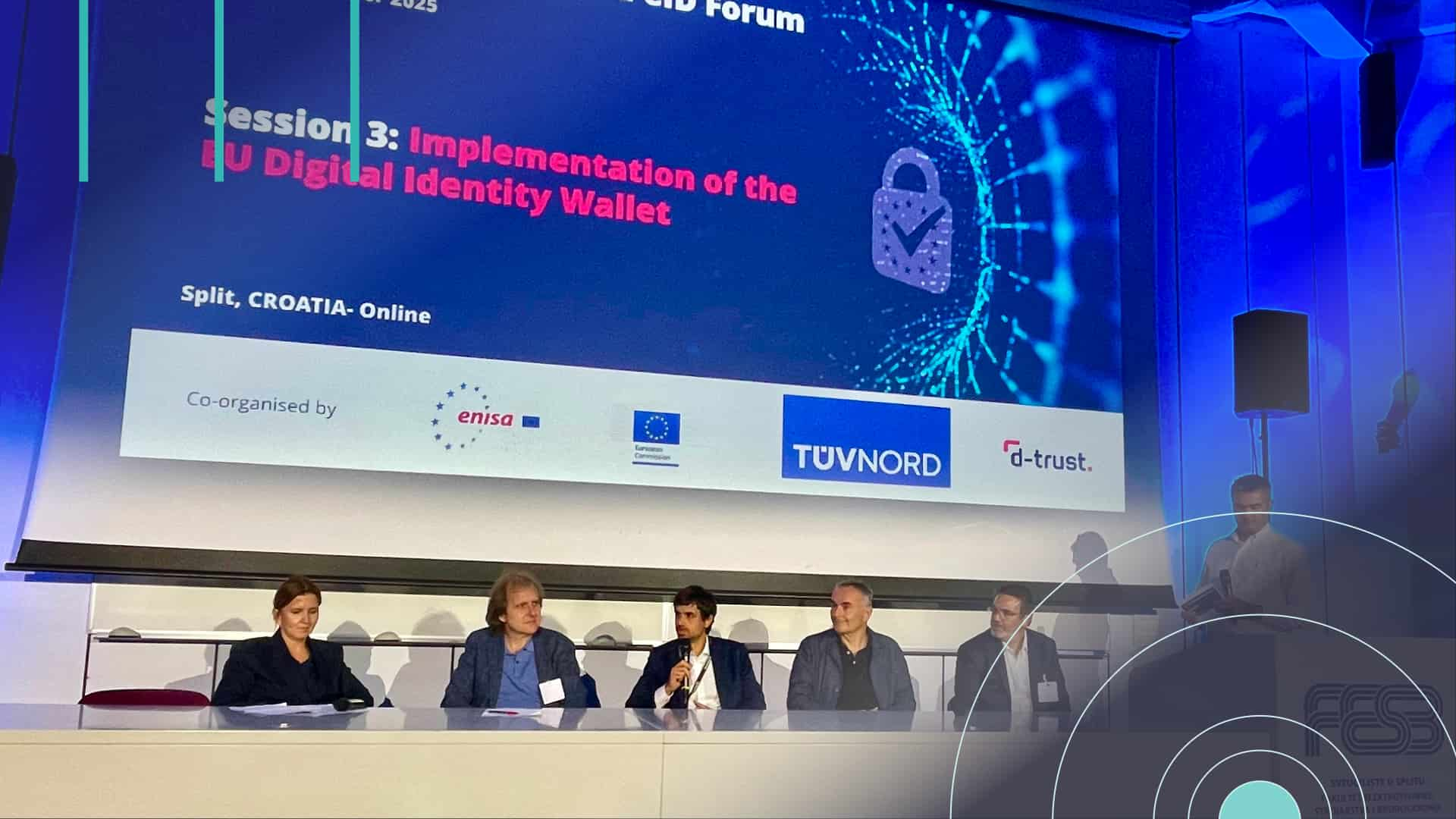O ENISA Trust Services and eID Forum, realizado juntamente com o CA Day em Split, mais uma vez serviu como plataforma central para debater o futuro da identidade digital, dos serviços de confiança e dos desenvolvimentos regulatórios na Europa. Stakeholders da indústria, reguladores, organismos de avaliação de conformidade e representantes de usuários discutiram oportunidades e desafios na implementação do eIDAS 2.0, adoção de wallets e práticas de supervisão. Este ano, as discussões também abordaram desenvolvimentos internacionais nos Estados Unidos, Japão e outros países, além de novos domínios como o European Business Wallet. A seguir, as dez percepções mais importantes que clientes, parceiros e observadores do setor devem reter:
1. Colaboração transfronteiriça é imprescindível
O sucesso do ecossistema europeu de identidade digital depende da cooperação entre países. Nenhum Estado-membro ou provedor privado pode ter sucesso isoladamente. Casos práticos demonstraram como governos nacionais e atores privados podem acelerar a adoção coordenando pilotos, governança e educação do usuário. Este modelo colaborativo deve servir como referência para outros Estados-membros, especialmente com os prazos obrigatórios do European Digital Identity Wallet (EUDI Wallet) em 2026 e 2027.
2. Pontos de partida diferentes moldam estratégias nacionais
Há diversidade de abordagens entre os Estados-membros. Alguns países já possuem esquemas eID maduros e amplamente adotados, enquanto outros partem quase do zero. Em mercados avançados, provedores aproveitam altas taxas de adoção para testar funcionalidades de wallets de forma independente, às vezes fora do alinhamento estrito com o EUDI Wallet. Mercados menos avançados buscam orientação em frameworks europeus. Essa disparidade ressalta a necessidade de estratégias de implementação flexíveis e evidencia a complexidade e importância da harmonização europeia.
3. Monetização de atributos: o tema central
O debate sobre a sustentabilidade financeira dos wallets continua. A viabilidade técnica foi demonstrada por pilotos em larga escala, como DC4EU, EWC, NOBID e POTENTIAL. O verdadeiro desafio é construir modelos de negócio viáveis. A monetização de atributos continua sendo central: emissores e relying parties devem perceber benefícios claros, caso contrário, os wallets correm o risco de permanecerem ferramentas de compliance sem incentivos para adoção mais ampla.
Do ponto de vista da Namirial, foi enfatizado que o ecossistema precisa urgentemente de modelos práticos que demonstrem como a monetização de atributos funciona na prática. Atenção especial foi dada a abordagens privacy-preserving, incluindo o padrão ETSI TR 119 479-2 promovido pela Namirial, que busca equilibrar sustentabilidade do negócio e conformidade rigorosa com a proteção de dados. A monetização, quando bem projetada, pode reforçar a confiança e fornecer incentivos a emissores e relying parties.
4. Identity proofing: complexo, mas essencial
A verificação de identidade é uma das atividades mais intensivas em recursos na identidade digital. Os padrões ETSI TS 119 461 v2 e correlatos definem requisitos para níveis de assurance, mas a implementação operacional continua desafiadora. Provedores devem gerenciar prevenção de fraude, conformidade regulatória e experiência do usuário simultaneamente. A complexidade excessiva pode desincentivar a adoção. Muitos stakeholders enfatizaram a necessidade de simplificação sem comprometer a confiança, garantindo que o identity proofing permaneça robusto e manejável.
5. Certificação e supervisão exigem agilidade
Órgãos de supervisão e a ENISA destacaram que os frameworks de certificação estão evoluindo, mas lacunas permanecem. Conformity Assessment Bodies (CABs) estão tecnicamente preparados para auditar novos serviços de confiança, mas não podem emitir relatórios até estarem acreditados conforme o framework revisado. Em setembro de 2025, nenhum CAB havia completado o processo, gerando preocupações sobre atrasos. A ENISA constituiu um Ad-hoc Working Group (AHWG) para elaborar um Conformity Assessment Scheme (CAS), com revisão por pares prevista para 2026 e implementação a partir de 2028. Até lá, esquemas nacionais devem preencher a lacuna, e o reconhecimento mútuo entre países será essencial.
6. Dados e perspectiva do usuário são importantes
Pesquisas apresentadas no Forum ressaltam que a adoção ocorrerá apenas se os usuários perceberem valor tangível. Benefícios como onboarding mais rápido, redução de fraudes e acesso a novos serviços digitais impulsionam a adoção. Giorgia Dragoni, do Digital Identity Observatory, POLIMI School of Management, forneceu insights valiosos sobre as dinâmicas de adoção. A comunicação continua sendo crítica: os usuários precisam entender não apenas a disponibilidade de wallets, mas por que usá-los facilita sua vida diária. Sem design e comunicação centrados no usuário, a regulação sozinha não garante adoção.
7. Competitividade e sobre-regulação
O futuro do ecossistema europeu depende do equilíbrio entre ambição regulatória e competitividade. A regulação é necessária para garantir confiança e segurança, mas rigidez excessiva pode prejudicar a inovação. A indústria lembra que a Europa deve manter operadores privados competitivos globalmente. Espera-se consolidação do mercado com aumento de requisitos de conformidade, e a escala transfronteiriça se torna uma vantagem decisiva. Sobre-regulação poderia afetar a competitividade enquanto players internacionais avançam rapidamente.
8. Segurança e resiliência: NIS2, DORA, CRA
Provedores de serviços de confiança operam sob múltiplas camadas regulatórias: eIDAS 2.0, NIS2, Cyber Resilience Act (CRA), Digital Operational Resilience Act (DORA). Esses frameworks sobrepostos criam riscos de auditorias duplicadas e relatórios fragmentados. Reguladores exploram harmonização para que a conformidade com eIDAS também satisfaça as obrigações do NIS2. Provedores devem adotar gestão de risco e estratégias abrangentes de cibersegurança, além de se preparar para pressões de consolidação devido aos altos custos de conformidade.
9. Pilotos em larga escala mostram viabilidade, mas não incentivos
Pilotos financiados pela UE demonstraram que a interoperabilidade de wallets funciona na prática, inclusive em setores como finanças, saúde e mobilidade. No entanto, esses pilotos mostraram que a viabilidade técnica não é suficiente: faltam incentivos. Emissores de atributos, relying parties e provedores de wallets devem perceber um caso de negócio claro. Sem isso, os wallets podem estagnar, apesar de demonstrações técnicas bem-sucedidas. Os legisladores foram instados a garantir que os incentivos estejam incorporados ao framework desde o início.
10. Caminho à frente: adoção, Business Wallet e PQC
Três prioridades estratégicas emergem:
- Adoção: o uso de wallets é voluntário; a adesão depende de valor claro para o usuário, apoiado por educação e comunicação.
- European Business Wallet (EUBW): até o final de 2025, espera-se que a Comissão Europeia publique uma proposta para permitir que empresas mantenham e apresentem credenciais como LEI, mandatos e certificações empresariais, ampliando significativamente o conceito de wallet além do indivíduo.
- Post-Quantum Cryptography (PQC): necessidade urgente de agilidade algorítmica; os provedores devem planejar hoje os caminhos de migração, mesmo que os padrões finais de PQC ainda estejam se estabilizando.
Contexto global: desenvolvimentos fora da UE
Nos EUA, mais de 18 estados emitem mobile IDs compatíveis com ISO/IEC 18013-5, aceitos pela TSA em aeroportos. Espera-se uma solução digital integrada a passaportes no final de 2025. O Reino Unido avançou com o Digital Identity and Attributes Trust Framework (DIATF) e anunciou identidade digital obrigatória para comprovação de direito ao trabalho. Em 28 de setembro, cidadãos suíços aprovaram a introdução de identidade eletrônica. Japão, Canadá e Austrália ampliam pilotos de wallets, enquanto a OpenWallet Foundation promove infraestrutura open-source. O verifiable LEI (vLEI) da GLEIF ganha relevância como credencial corporativa global. Stakeholders europeus participam ativamente para garantir interoperabilidade e reconhecimento mútuo.
Perspectiva Namirial
Para a Namirial, o Forum reafirmou três mensagens estratégicas:
- Adoção primeiro: wallets só terão sucesso se usuários e empresas perceberem benefícios claros.
- Consolidação à frente: requisitos para QTSP estão aumentando, e a Namirial está construindo ativamente o maior QTSP da Europa para atender a essas demandas.
- Incentivar atributos: a monetização deve ser oportunidade para emissores e relying parties, não um ônus para os usuários.
Essas prioridades refletem-se nos produtos e soluções da Namirial:
- Namirial Onboarding: otimiza verificação de identidade de clientes atendendo aos mais altos padrões regulatórios.
- Namirial Sign: oferece assinaturas eletrônicas seguras, escaláveis e acessíveis.
- Namirial Wallet Platform: permite participação plena no EUDI Wallet e no futuro European Business Wallet.
O Forum 2025 reforçou que a Europa está em um ponto crítico: fundamentos regulatórios avançam, pilotos demonstram viabilidade e novos serviços como o Business Wallet estão emergindo. Persistem incertezas sobre certificação, autenticidade e incentivos para adoção. Comparações internacionais mostram que outras regiões avançam rapidamente, e a Europa deve permanecer ágil. A colaboração entre reguladores, provedores e usuários continua sendo decisiva.
A Namirial orgulha-se de estar na linha de frente deste processo contínuo de inovação e mudança, reforçando seu compromisso de impulsionar o futuro dos serviços de confiança e da identidade digital junto ao ecossistema europeu.


